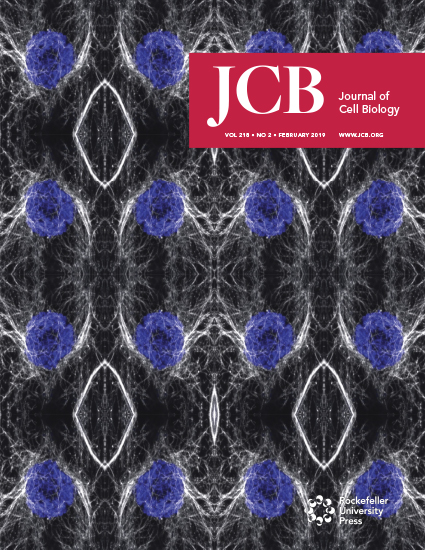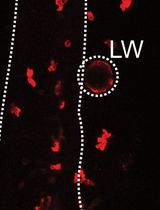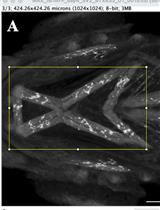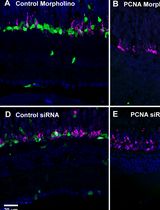- EN - English
- CN - 中文
Retina Injury and Retina Tissue Preparation to Study Regeneration in Zebrafish
通过斑马鱼视网膜损伤和视网膜组织制备进行视力恢复研究
发布: 2019年12月20日第9卷第24期 DOI: 10.21769/BioProtoc.3466 浏览次数: 4973
评审: Subhra Prakash HuiNobuhiko TachibanaAnonymous reviewer(s)
Abstract
Unlike mammals, primitive vertebrates have immense capability to regenerate almost all of their organs including the central nervous system. Among primitive organisms, zebrafish have been extensively used as a model system for regeneration studies. The retina is a part of the central nervous system and mammals lack the potential to repair any damage caused to it. Zebrafish have been used for retina regeneration studies because of ease in handling and maintenance. In zebrafish, Muller glia cells respond to damage and enter the regenerative cascade to maintain the retinal homeostasis. Zebrafish retinal damage can be induced by light, chemical or mechanical methods. Here we are describing the mechanical method of retinal injury, which ensures uniform damage to all retinal layers. Alongside this, we have also described in vivo manipulation strategies for the regeneration associated genes and preparation of retinal tissue for immunohistochemical analysis.
Keywords: Zebrafish (斑马鱼)Background
Retina is the sensory part of the eye and any physical or physiological damage leads to impairment of vision. In the course of evolution higher vertebrates have lost the regenerative potential while primitive vertebrates have enormous capability to regenerate their lost vision. Studying the regenerative events in primitive organisms such as zebrafish can be a hope for mammalian regeneration studies. Zebrafish have been used for retina regeneration studies with various injury paradigms being used. The photobleaching method damages the photoreceptor cells, while chemical methods damage the ganglion cell layer. Mechanical injury by the stab wound method maintains a uniform injury to all retinal layers. Various approaches including transgenic approaches have been used to find the relevance of genetic events during retina regeneration. Here we are describing the in vivo method for mRNA transfection which allows manipulation of gene expression levels above endogenous levels.
Materials and Reagents
- 30G needle (BD Microlance, 30G ½”, 0.3 x 13 mm, catalog number: 304000)
- Centrifuge tubes (Tarsons, catalog number: 500010x)
- Paper towels (Scott SCOTTFOLD Towels, 31.4 cm x 19.9 cm, catalog number: 01960)
- Hamilton syringe (Hamilton Company, 10 µl, catalog number: MICROLITERTM #701)
- Staining box (Custom made by fixing two plastic pipettes parallel to each other at the bottom of a rectangular plastic box)
- Glass slides (Superfrost Plus Microscope Slides) (Fisher Scientific, catalog number: 12-550-15)
- pCS2+ plasmid (David Turner, University of Michigan, Ann Arbor)
- Ethyl 3-aminobenzoate, methane sulfonic acid salt, Tricaine methanesulfonate (Acros, catalog number: 118000500)
- 2x HBSS (Diluted from 10x solution, see Recipes)
- mMESSAGE mMACHINE SP6 kit (Thermo Fisher, catalog number: AM1340)
- Lipofectamine messenger max reagent (Invitrogen, catalog number: LMRNA001)
- DABCO (1,4 diazabicyclo [2.2.2] octane, Sigma-Aldrich, catalog number: D27802)
- Na2HPO4 (Sodium phosphate dibasic, Sigma-Aldrich, catalog number: 255793)
- NaH2PO4 (Sodium phosphate monobasic, Sigma-Aldrich, catalog number: 33198)
- KCl (Potassium chloride, Himedia, catalog number: MB043)
- HEPES (Sigma-Aldrich, catalog number: H3375)
- Glucose (Sigma-Aldrich, catalog number: G8270)
- Tissue-Plus O.C.T. compound (Fisher Health care, catalog number: 4585)
- BSA (Bovine serum albumin fraction-V, Himedia, catalog number: GRM105)
- Triton X-100 (Sigma-Aldrich, catalog number: T8787)
- BrdU (5-Bromo-2’-deoxyuridine, Sigma-Aldrich, catalog number: B5002)
- PFA (Paraformaldehyde, Sigma-Aldrich, catalog number: P6148)
- PVA (Polyvinyl alcohol, Sigma-Aldrich, catalog number: P8136)
- Glycerol (Sigma-Aldrich, catalog number: G7757)
- Tris Base (Trizma base, Sigma-Aldrich, catalog number: T1503)
- HCl (Hydrochloric acid, Sigma-Aldrich, catalog number: 320331)
- Sucrose (Sigma-Aldrich, catalog number: S0389)
- Tris-HCl (1 M, pH 7.5, 100 ml) (see Recipes)
- Tricaine methanesulfonate solution (100 ml) (see Recipes)
- Phosphate buffer (PB, 1 M, pH 7.4, 100 ml) (see Recipes)
- Phosphate buffered saline (PBS, 10x, pH 7.4, 1 L) (see Recipes)
- HBSS (Hanks balanced salt solution, 10x, pH 7.14, 100 ml) (see Recipes)
- 4% PFA (50 ml) (see Recipes)
- DABCO (2.5%, 50 ml) (see Recipes)
- Sucrose solutions (50 ml) (see Recipes)
Equipment
- Forceps (McPherson Suture Tying Forceps Straight-With Tying Platform 10cm (4”) 5 mm size, jaw length, Surtex Instruments, catalog number: FR-780-10)
- Stereomicroscope (Carl ZeissTMStemiTM DV4 Series Stereomicroscopes with LED Illumination)
- Electroporator (Electro Square Porator, BTX Harvard Apparatus, model: ECM 830)
- Electrodes (Platinum Tweezertrode, 5 mm Diameter with 45-0204 cables, BTX, catalog number: 45-0489)
- Cryostat (Leica, model: CM3050 S)
- Rotospin Rotary Mixer (Tarsons)
- Shaking water bath (Stuart, model: SBS40)
- Centrifuge (Labocene, catalog number: ScanSpeed 1736R)
- Nikon Ni-E fluorescence microscope and Nikon A1 confocal imaging system (Nikon A1-SHS, catalog number: 10225)
Procedure
文章信息
版权信息
© 2019 The Authors; exclusive licensee Bio-protocol LLC.
如何引用
Readers should cite both the Bio-protocol article and the original research article where this protocol was used:
- Sharma, P. and Ramachandran, R. (2019). Retina Injury and Retina Tissue Preparation to Study Regeneration in Zebrafish. Bio-protocol 9(24): e3466. DOI: 10.21769/BioProtoc.3466.
- Mitra, S., Sharma, P., Kaur, S., Khursheed, M.A., Gupta, S., Chaudhary, M., Kurup, A.J., and Ramachandran, R. (2019). Dual regulation of lin28a by Myc is necessary during zebrafish retina regeneration. J Cell Biol 218: 489-507.
分类
干细胞 > 多能干细胞 > 再生医学
细胞生物学 > 细胞成像 > 共聚焦显微镜
神经科学 > 感觉和运动系统 > 视网膜
您对这篇实验方法有问题吗?
在此处发布您的问题,我们将邀请本文作者来回答。同时,我们会将您的问题发布到Bio-protocol Exchange,以便寻求社区成员的帮助。
提问指南
+ 问题描述
写下详细的问题描述,包括所有有助于他人回答您问题的信息(例如实验过程、条件和相关图像等)。
Share
Bluesky
X
Copy link












